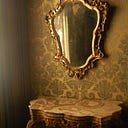The Beginning of your Design Career
This was first published on my mailing list The Looking Glass. Every week, I answer a reader’s question.
How do you get started on the path of a successful product design career?
Over these weeks, many of you have asked about what it takes to get started as a designer. I’ve gotten questions from contractors wondering how to get a full-time gig, engineers or product managers wanting to make the leap into a user experience career, and recent design students wondering how they should approach their first few years in the workforce.
I put off answering it because the question was intimidatingly broad, and there are also many, many great resources already out there on improving as a designer (I’ll plug here the articles and tips from some of the amazing folks on the Facebook Design team around good critique practices, investing in your design education, dealing with imposter syndrome, and more).
But every week when I see this question, I think on it. What would be the practical advice for someone just starting out in design? How to strike the right balance between writing a detailed tome and extracting the most useful nuggets?
So now, over a month later, here’s what I’ve got:
In the beginning, just focus on improving your craft and execution skills.
This means that you should be able to design clear, interactive flows that also look visually attractive. My strong opinion here is that you need to be good at both interaction design AND visual design. If you can only do one, you’re at a disadvantage. As a product designer, you want to paint an inspiring vision of the possible future of your product. The hottest aesthetics can’t overcome a UI that’s confusing, and let’s be honest — nobody gets excited looking at a bunch of wireframes. So when you are just getting started, just focus on sharpening these foundational skills. Develop your eye for what good visuals looks like. Get familiar with what makes things simple to understand and what makes things confusing. Know how to quickly put together a high-fidelity prototype. If you can get to the point where everything you make looks great and makes sense, you will not have trouble landing a design job.
After that, focus on improving your product thinking.
Strong product thinking means that you understand what a good outcome is and how to design an experience that would lead to those good outcomes. The better you are at this, the bigger and more ambiguous the problems you can take on, starting from simple interaction prompts like “design a flow that allows people create an account on this service” to meatier challenges like “design a new user experience that helps people understand the value of this service so that they come back again the next day.” The latter requires a much deeper understanding of human motivation and comprehension. If you can solve those kinds of problems, companies will be tripping over themselves to hire you.
Finally, work on your influencing skills.
You can consistently produce the best design work in the world, but if you can’t get other people to see your perspective or want to help bring your vision to life, your impact will be capped. Once your hard skills are in a good place, work on your soft skills: communicating clearly; pitching a compelling vision; knowing what matters to whom; collaborating well with others. Those skills are critical for growing your leadership in every profession, not just product design.
To ask a question or follow along with more articles like this, subscribe to The Looking Glass.

